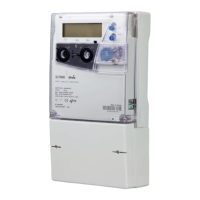26
6.1. Metrology
The meter current sensors are integral Mutual Conductance Transformers, which provide a wide dynamic range
and guarantee high stability over the operating temperature range of the meter.
The three current sensors generate a signal per phase that is proportional to the instantaneous current, while
voltage signals are derived by dividing the distribution-network line voltages through a resistive divider.
The current and voltage input signals are sampled and digitised 40 times per cycle (50Hz) by an analogue to
digital (A-to-D) converter, then processed by a microcontroller to derive various energy values. The
microcontroller records these values in a suite of registers that are independent of any meter configuration and
are always available.
These registers accumulate their respective energy values in an incremental fashion, until they reach the register
limit. At that point they are automatically reset to zero in the same way as roll-over electromechanical meter
types.
The contents of these registers can be displayed at any time as instantaneous values on the meter LCD.
The microcontroller also controls the data transfer to the various inputs and outputs, visible metrological LEDs
and infrared port.
Measurement error correction
The meter can be configured to take into account any measurement errors introduced by the current (CT) and
voltage transformers (VT). This facility increases the global accuracy by applying a correction to the applicable
measured and/or calculated values within the meter.
Two types of correction can be applied:
• voltage and current amplitude correction to compensate for any transformer ratio errors
• voltage and current phase angle correction to compensate for any transformer angle errors
CT/VT correction can only be configured using the meter support tool and must be carried out with regard to the
accuracy of the connected transformer.
Note: This feature is not available for MID compliant meters.
6.2. External connections
The meter may be configured with a number of input and output facilities, as detailed in this section.
6.2.1. Control input
The meter can be factory-configured with a number of control inputs for connection to further meters or other
external equipment such as time switches.
The control inputs can be individually assigned and used to trigger meter actions such as:
• forcing the end of an integration (EOI) or billing (EOB) period
• clock synchronisation
• indicating an external alarm
• changing the tariff rate
• changing calendar parameters such as season or day profile
• display scrolling
• pulse input direction

